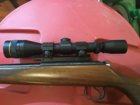Unless it is turned backwards, putting a 20 MOA canted scope mount on a rifle setup for which the elevation already is insufficient to zero at close range will make the problem even worse (i.e. the greater the cant in the base, the more low end elevation adjustment you lose). The whole point of using a canted base is to regain some of the lower half of the elevation travel range to gain more [usable] upper half adjustment for longer range shooting. That CZ 20 MOA mount could probably be turned around backwards to address this specific issue, but 20 MOA might be more total adjustment than is necessary.
One problem with zeroing a scope that has a modest or limited elevation travel range at extremely close distances (i.e. 25 yd) is that the change in point of impact (POI) per turret click on the target face is halved at 50 yd, and halved again at 25 yd. Because we are dealing with angular subtension and reticle adjustment, changing the POI by some specified linear distance on the target face at 25 yd takes 4 times the amount elevation turret adjustment as changing the POI by the same linear distance on the target face at 100 yd. In other words, changing the POI by ~one inch on the target face at 25 yd requires a ~4 MOA turn of the elevation knob (for MOA turrets). Changing the POI by ~one inch at 100 yd requires only 1 MOA turret adjustment. So a scope with modest elevation travel will tend to bottom out much more quickly at distances well under 100 yd.
Switching to the appropriate set Burris Signature [adjustable] rings with a set of plastic inserts might be a fairly simple way to fix this issue. I believe you can get them with 0, 5, 10, and 20 MOA inserts. Some combination of those inserts should allow you to correct the issue you're having zeroing at close range. As mentioned by jds holler above, you need to end up with the scope objective lens pointing higher than it currently is in order to gain a little more low end elevation travel. That is the opposite of what long range shooters are generally trying to accomplish, in that they will use a canted base for the scope that causes it to point further downward in order to gain more upward elevation travel. The Burris Signature rings with inserts give you the option of raising the scope objective lens (i.e. in front), because you can use a taller insert in the front ring and a lower one (or zero MOA) insert in the back. With a canted scope mount or base, you can sometimes achieve the same goal by turning it around backwards, as they are usually designed to extend the range, not zero at closer distances. However, they aren't always designed to be turned around backwards. The Burris ring are an easy fix, and not very expensive.













